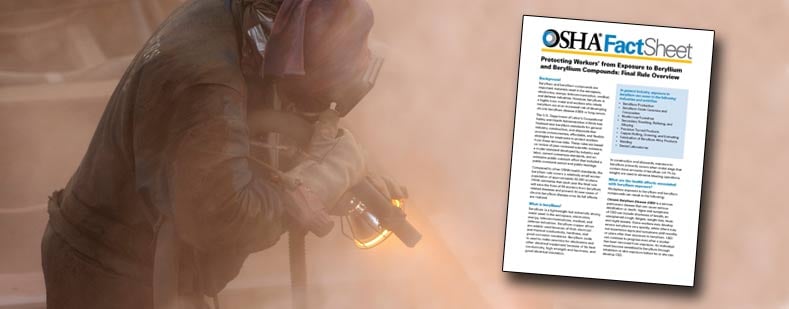On Monday, January 9th, OSHA (Occupational Safety and Health Administration) finalized new beryllium standards for professions commonly exposed to Beryllium. Several are affected including workers in the marine and construction industries. OSHA’s new ruling on Beryllium confirms that at trace levels, beryllium can be harmful. Long-term beryllium exposure can lead to berylliosis, as well as cancer and heart failure. According to author John Emsley, a third of those who contract berylliosis die, leaving the rest permanently disabled.
The OSHA held its permissible exposure limit (PEL) to 2.0 micrograms per cubic meter of air since the 1940s. After extensive studies and a push by worker safety advocates, OSHA dropped the PEL for beryllium to 0.2 micrograms per cubic meter - a 1000% percent reduction.
OSHA estimates that nearly 62,000 workers are potentially exposed to beryllium in approximately 7,300 establishments in the United States. This ruling is raising awareness for those that blast with coal slag. While basters wear PPE, surrounding workers and trades do not always use the same precautions. OSHA states, “While the highest exposures occur in the workplace, family members of workers who work with beryllium also have potential exposure from contaminated work clothing and vehicles.”
OSHA identifies individuals working as primary beryllium production workers, workers processing beryllium metal/alloys/composites, foundry workers, furnace tenders, machine operators, machinists, metal fabricators, welders, dental technicians, and abrasive blasters using slags (copper slag and coal slag) to be at the highest risk of beryllium exposure.
Many contractors in the abrasive blasting industry continue to use hard, cheap substances as media for their sandblasting systems. Coal slag, which is otherwise a hazardous waste byproduct of coal power plants is a very inexpensive media. Beryllium in coal slag makes it toxic and deadly. This follows the same pattern that blasting operations went through with sand, the original sandblasting media. Silica was known to be a carcinogen for many years before its use was discontinued in the US. Many European countries began banning silica sandblasting as early as 1947.
Alternative (low beryllium, silica free) abrasives used for sandblasting include Sponge Media, garnet, and steel grit. These “non-beryllium and non-silica” abrasives preform at comparable rates for the removal of industrial coatings, rust, and profiling metal. Nontoxic abrasives have been on the market for several years. OSHA has outlined several of the risks of abrasive blasting in this OSHA Fact Sheet. Sponge abrasives are the only media listed as “less toxic” while still profiling metal for coating.
Resources:
OSHA’s Beryllium Fact Sheet








